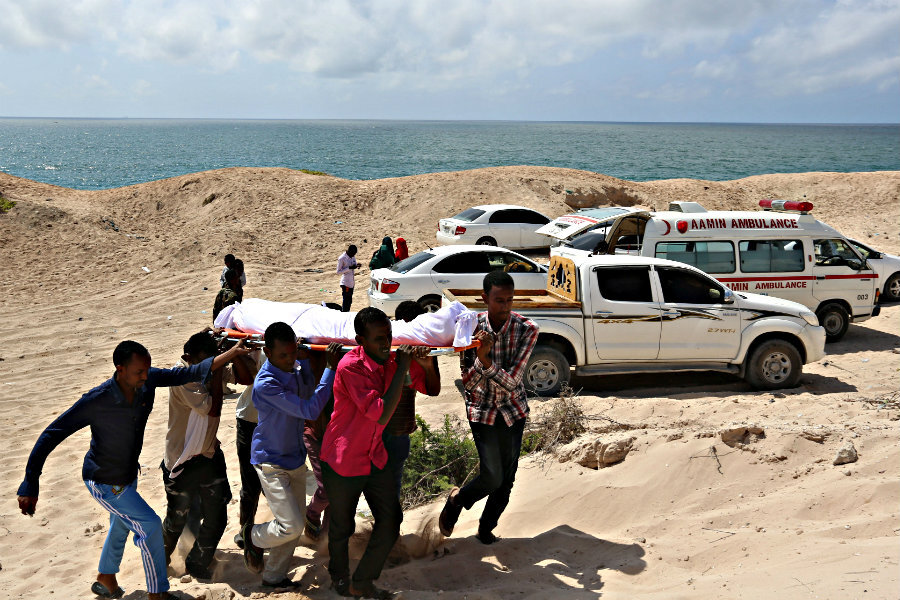Where are journalists under threat?
Loading...
With 24 journalists killed without recourse over the last decade, Somalia topped the Committee to Protect Journalists’ (CPJ) annual list of the world’s most dangerous places for journalists.
Titled "Getting Away With Murder - 2016 Global Impunity Index," the report was released on Thursday, and identifies the 13 countries where journalists face the most danger in their profession.
In countries where the law does not protect reporters, media experts say that journalists’ lives are not all that is at stake - so are central values of freedom of the press and truth in reporting.
“When journalists feel unsafe, when there is no prosecution following journalist killings, it can intimidate the entire media community,” says report author Elisabeth Witchel in a phone interview with The Christian Science Monitor, “which affects a range of issues.”
In the countries examined in the CPJ report, both state and non-state actors are often behind journalist killings and intimidation. From local politicians who take exception to media investigations to terrorist groups, journalists who seek to expose corruption, reveal the truth about different organizations, or simply cover certain individuals, are at risk.
The Committee to Protect Journalists analysis of the situation in Somalia, for example, includes the story of pro-government radio station producer Daud Ali Omar, who was killed in his sleep alongside his wife by unidentified armed men. Although the men are most likely linked to the militant group Al Shabab, they have not been apprehended or prosecuted.
Thousands of miles away in the Philippines, No. 4 on the Committee’s list, 32 members of the media were killed in one massacre in 2009. Although there are approximately 80 individuals accused of carrying out the crime, not a single one has been prosecuted. At least four witnesses have since been murdered.
“We’ve seen that in places of high rates of impunity, we see killings repeat,” says Ms. Witchel. “When governments don’t respond to killings, it sends the message to killers that it is OK and that they can get away with it.”
In some countries, such as Iraq, Syria, and Mexico, where non-state actors such as terrorist groups or drug cartels are powerful, many of the killings are believed to be perpetrated by non-governmental groups, which does make them hard to prosecute. According to Witchel, governments in countries where non-state actors are present sometimes try to blame all journalist killings on hard-to-track non-state actors, but, “that isn’t necessarily the whole picture,” she says. “Sometimes government officials are involved too.”
About 40 percent of journalists killed in the past decade reported receiving threats before they were murdered. In more than 40 percent of the killings that the Committee to Protect Journalists examined, the suspected perpetrators were political groups, particularly extremist groups such as the Islamic State.
In another 25 percent of cases, the perpetrators were likely government officials, according to the report. Ninety-five percent of reporters killed were local reporters, most of whom focused on issues of corruption and politics.
International Center for Journalists Knight Fellow Jorge Luis Sierra tells the Monitor that in Mexico, No. 6 on the Committee’s list, many journalists are forced by financial circumstances to take second jobs as taxi drivers and other professions.
Since the majority of journalists killed in Mexico are local reporters in drug cartel-dominated states, he says, it is easy for the government to blame their deaths on alleged connections to cartels through journalists’ second jobs.
“Journalists are intimidated on a daily basis,” he says, “and they are really not allowed to verify information or do other aspects of the profession.”
The presence of countries such as Mexico, Brazil, and India on the impunity list (Nos. 4, 9, and 13, respectively) were among the most surprising of the report’s findings for author Witchel.
“People expect Iraq and Somalia,” she says, “but when you do look at countries that are part of the community of democracies like India and Mexico, it is a surprise that they allow this to go on.”
Nevertheless, there are some bright spots to this year's report, Witchel tells the Monitor. More countries are making progress with beginning to follow up on reports of press killings. And other countries are becoming more accountable to international governing bodies, responding to UNESCO information requests.
"There's been a strong, successful push to raise awareness of this issue," Witchel says.






